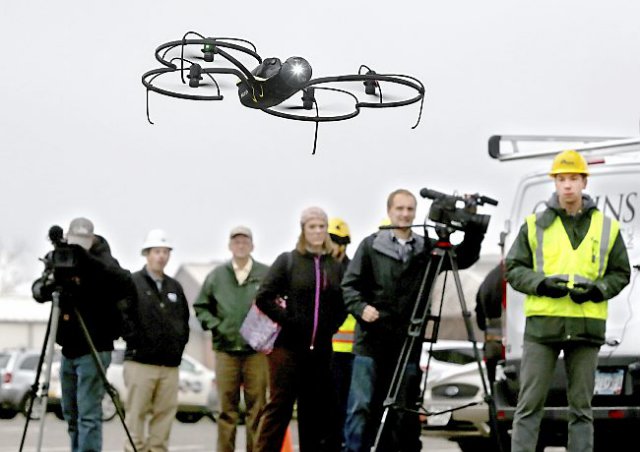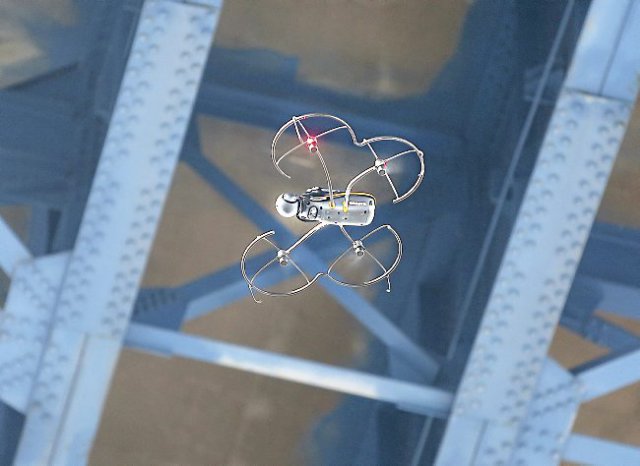 “We do underneath rope access inspections,” said Barritt Lovelace, a regional manager for Collins Engineers Inc., an agency headquartered in Chicago with offices throughout the country. “Basically, we rock-climb bridges. It’s a lot of fun.” In Duluth recently, Lovelace stood with a host of others below the Blatnik Bridge to participate in a demonstration of the Minnesota Department of Transportation’s ongoing study of using drones for bridge inspection purposes.
“We do underneath rope access inspections,” said Barritt Lovelace, a regional manager for Collins Engineers Inc., an agency headquartered in Chicago with offices throughout the country. “Basically, we rock-climb bridges. It’s a lot of fun.” In Duluth recently, Lovelace stood with a host of others below the Blatnik Bridge to participate in a demonstration of the Minnesota Department of Transportation’s ongoing study of using drones for bridge inspection purposes.
The study began in May with $34,000 of research funds and was just renewed through next June for $75,000.
Jennifer Zink, a MnDOT bridge inspection engineer, spoke to members of the media about the study, explaining how the state is among the first to consider drones for this purpose. She’s getting calls from across the country and as far away as England from transportation authorities inquiring about what the state is learning and, in short, she’s telling them all systems are still a go.
“We’re looking at drones to enhance inspections,” Zink said. “They’re not going to replace inspectors.”
Zink explained an array of benefits to using drones, including compressing the time inspections take, allowing for fewer road and lane closures, eliminating safety risks associated with closures and bringing added cost savings, including saving wear and tear on MnDOT’s snoopers — those trucks with hydraulic arms and buckets that reach out and back under a bridge.
Zink said MnDOT set drone photographs against the current standard for bridge inspection reports, and the drone photographs compared favourably.
The drone on display under the Blatnik Bridge was the second type to be tested by MnDOT. It’s a $40,000 Swiss model with a 360-degree high-resolution camera with the ability to shoot infrared so as to identify what Zink called “delaminations” that can’t be seen by the human eye.
At 3 1/2 pounds, the drone was light but sturdy enough to withstand the day’s gusts of wind. With a sleek frame disguising four horizontal propellers, the drone looked like one of those flying spiders from the jungle. It rose several stories with a constant hum and settled in several feet below the bridge.
At this point the drones aren’t expected to fly between trusses or in other confined spaces. The Federal Highway Administration, said both Zink and Lovelace, requires that inspectors get within arm’s reach of any non-redundant trusses on a bridge — meaning any of the steel that is “fracture critical” and, were it to break, would cause a catastrophic bridge failure.
The drone on display came in a hard suitcase and was agile and responsive, more than the rugged military model that was used to begin the study, Zink said. During flight it relayed real-time video to a computer on the ground. Zink seemed to like the Swiss model but said MnDOT would continue to test new drones; the agency doesn’t own the costly drones, but rather contracts for their use.
Lovelace said his company felt fortunate to be able to be brought into the fold of MnDOT’s study, allowing the firm to incorporate the future with its old-school methods.
Zink said the study to date has been so promising that it’s looking like drones will be a part of bridge inspections going forward as soon as later in 2016.
She speculated that drone inspections will be set up on multi-year contracts with the state’s counties, like the current arrangement with underwater bridge inspections, which are renewed every four years.
The study also will lead to the creation of best practices for drone usage.
About the only thing that could torpedo the drone program from going forward would be the Federal Aviation Administration’s restrictions and regulations, Zink said.
The drone on display carried an FAA registry number, like any aircraft, and required a commercial pilot to be on the ground during its operation. Drone inspections are not allowed to happen with 500 feet of bystanders, which would make some urban inspections tricky if not impossible.
But Zink said, if anything, drones will become more and more prominent, adding, “We’re finding out that drones are a lot more useful commercially for a lot of businesses.”
Top Photo: Adam Zylka (right), technical engineer with SenseFly, pilots a drone back to the ground at the Blatnik Bridge in Duluth after a test run for the media – Bob King / rking@duluthnews.com
Source: Twin Cities

